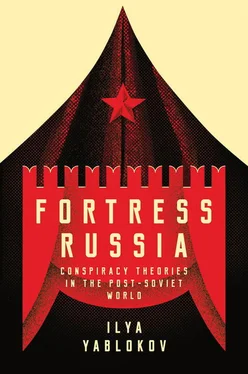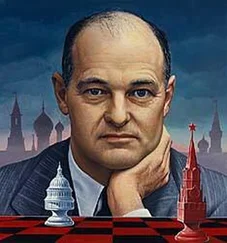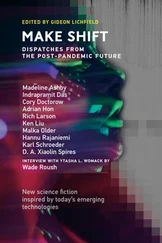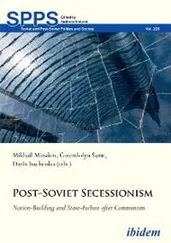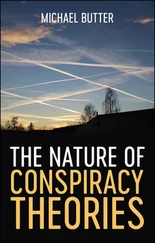4
Sovereign Democracy and its Enemies
After the collapse of the Soviet Union, the search for a new national identity became a serious challenge both for intellectuals and political elites. Various groups of intellectuals developed different approaches to the post-Soviet Russian nation, but many of them were based on the works of pre-revolutionary authors and did not fully correspond to the realities of the post-1991 world. Yeltsin’s government opted for a civic model of nation-building, introducing the notion of rossiiane (Russians). This model was based on the idea of a community of all citizens of the Russian Federation regardless of their ethnic or religious origins. However, it was challenged by other models which perceived the Russian nation as a community of Eastern Slavs, Russian speakers, ethnic Russians and Russians as an Imperial nation. This was reminiscent of the Soviet model of nation-building (Tolz, 2001, pp. 236–51, 267). Commitment to the building of a civic national identity was fairly constant throughout the Yeltsin era, but in order to attract voters, Yeltsin’s government also tried to depict the Russian nation in other ways, such as an Imperial nation or as part of the Eastern Slavic community.
When Putin came to power, this did not fundamentally change the approach towards nation-building, and the model of Russia as a civic nation continued to predominate. Both Putin and his supporters emphasized that Russia was a multi-ethnic country whose multi-cultural diversity provided stability for political development and for the maintenance of peace. This idea is enshrined in governmental policy (Prezident Rossii, 2012). However, during Putin’s years in the Kremlin, policies regarding nation-building have acquired two important new attributes. First, as Oxana Shevel (2011) demonstrated, the political leadership of post-Soviet Russia has been deliberately ambiguous when defining the nation-building agenda. This has allowed the political leadership to operate pragmatically, even opportunistically, to pursue its goals by shifting the terms of official discourse pertaining to geographical boundaries and to membership of the Russian nation. Second, debates about Russian national identity have become an efficient political tool, utilized in the pursuit of aims which were not always directly connected with nation-building issues.
The cynical deployment of conspiracy theories by political elites for the purpose of national cohesion can be dated back to 2004, when the Kremlin was faced with two serious challenges: the Beslan terrorist attack in 2004 that took the lives of 333 people, including 186 children, and the ‘colour revolution’ in Ukraine. First, the domestic threat posed by North Caucasian separatism was used to limit the power of regional governors and assert the Kremlin’s control over the regions. Explaining why there was no longer direct election of governors after Beslan, First Deputy of the Presidential Administration, Vladislav Surkov, stated that ‘unity of executive power’ was achieved through unity of the nation, and justified the political changes by reference to domestic threats:
We should all recognize that the enemy is at the gates. The frontline goes through every city, every street, every house… in a besieged country the fifth column of left- and right-wing radicals has emerged… Fake liberals and real Nazis have a lot in common. [They have] common sponsors from abroad. [They have] common hatred towards Putin’s Russia, as they describe it. In reality [it is a hatred towards] Russia as such. (Surkov, cited in Kaftan, 2004)
At the same time, the defeat of the pro-Russian candidate Viktor Yanukovich in Ukraine in 2004 caused concern that the transfer of power to Putin’s successor in 2008 might not be as smooth as was hoped. Describing the thoughts of the Russian political establishment in the aftermath of Ukraine’s ‘Orange Revolution’ in 2005, Pavlovskii noted: ‘There was a feeling that somewhere around these people [those protesting against the results of the presidential elections], those regiments ( polki ) are gathering to take to the streets of Moscow’ (Pavlovskii, cited in Putin, Russia and the West , 2012).
These events triggered a wave of conspiracy theories, which were aimed at mobilizing Russians in support of Putin’s leadership and against the purported threat of domestic subversion. This mobilization was achieved largely by stirring up debate about Russian national identity and the new Russian ideology (Finkel and Brudny, 2013), with conspiracy theories playing a crucial role in this process. Defined by Surkov as a sovereign democracy , Russia, in official discourse, started to be juxtaposed to the West in terms of political, national and religious differences. In the view of pro-Kremlin intellectuals, Russian greatness and the country’s history of determining the agenda of global politics were constantly being challenged by European and American governments in an attempt to undermine and split the country into numerous ‘puppet’ states. Thomas Ambrosio noted (2009, pp. 71–9) that Surkov’s sovereign democracy was one of the major discursive instruments invented by the Kremlin to insulate Russia from democratization and to facilitate an authoritarian backlash in the 2000s. The conspiratorial nature of the concept was aimed not only at achieving obvious political outcomes for the Kremlin, but also at the promotion of the new nation-building project.
In this chapter, it will be argued that since the mid 2000s the political elites of post-Soviet Russia, including top-ranking politicians, have been making more use of the notion of the West as the conspiring ‘Other’ for the purpose of nation-building. The ambiguity of the nation-building agenda has enabled the Kremlin to pursue pragmatic political goals, often aimed at the suppression of political opposition. In this context, dividing society into ‘the people’ and the ‘Other’, by using conspiracy theories to facilitate social cohesion, appear designed to meet the Kremlin’s goals: to boost national cohesion in support of the regime and to suppress opposition. However, Putin’s return to the presidency in 2012 marked a significant change in official discourse on national identity. As the controversy around the Pussy Riot performance demonstrates, at times which are considered critical for the Kremlin, Russia’s political leadership and the state-aligned media promote a less ambiguous image of the Russian nation: it is now Orthodox and conservative.
Theorizing the New Russian Identity
Vladislav Surkov is one of the most intriguing and ingenious Russian politicians of the post-Soviet era. He began his career as Mikhail Khodorkovsky’s bodyguard in the turbulent period of Gorbachev’s perestroika , but quickly evolved into highly ranked manager responsible for public relations in Khodorkovsky’s company, MENATEP. In 1999, he joined the Presidential Administration and for twelve years was its deputy head, sharing responsibility for domestic politics. An amateur writer and fan of American hip-hop (Wikileaks, 2010), Surkov’s initiatives in many ways defined Putin’s regime: the fear that the state would collapse without the strong hand of a leader like Putin is among the central ideas of the 2000s (Surkov, quoted in Voronin, 2013). More than a decade in the Kremlin before his unexpected departure against the background of the street protests of 2011, Surkov was something of a court philosopher and chief designer of the ideological concepts behind Russia’s authoritarian turn (Sakwa, 2011). The idea of Russia as ‘sovereign democracy’ is his favourite creation, though many Russia observers criticize the concept for helping to preserve the worst aspects of Putin’s Russia: isolationism, corruption and propaganda (Judah, 2013).
Читать дальше
Конец ознакомительного отрывка
Купить книгу
